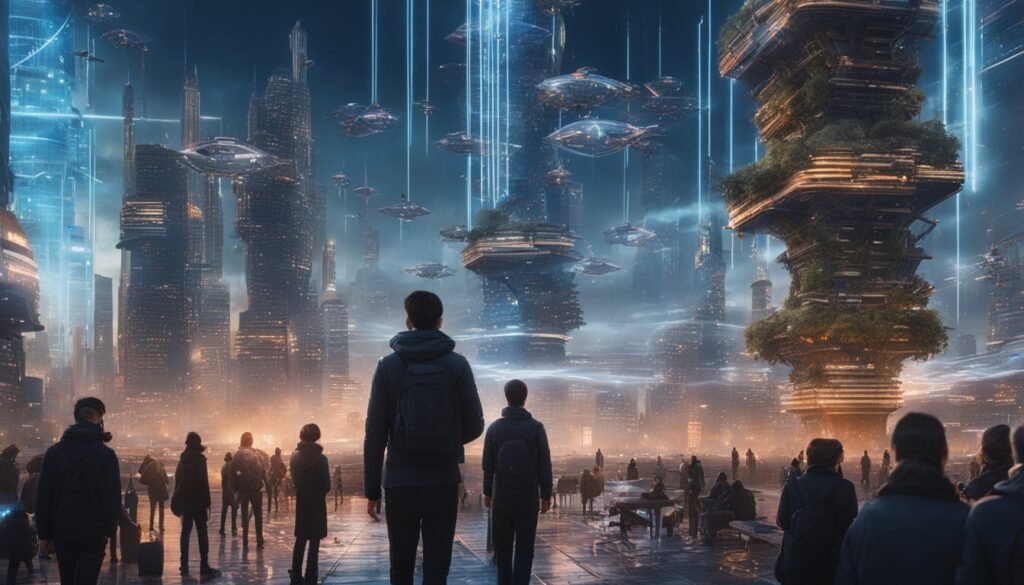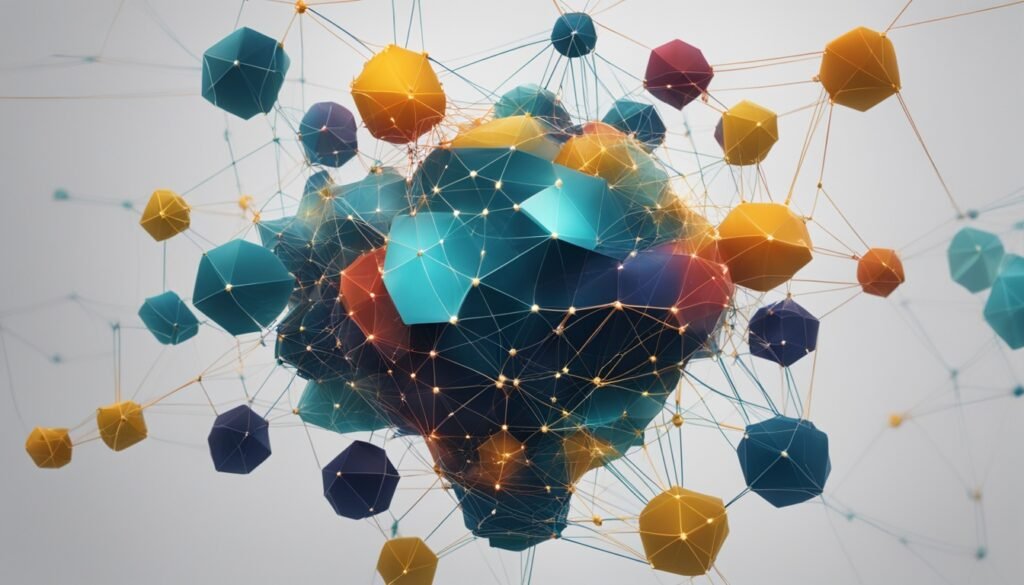A recent report says we’ll spend over $1 trillion on AI in the next few years. This shows how much money and effort is going into artificial intelligence (AI). Many think AI will change our world and maybe even take over. But experts say we should be careful about how much AI will change things, especially in the short term.
Key Takeaways
- Experts argue that truly transformative changes from AI won’t happen quickly, and few – if any – will likely occur within the next 10 years.
- The economics of AI versus earlier technological breakthroughs are questionable, as AI technology is exceptionally expensive, and to justify those costs, the technology must be able to solve complex problems, which it isn’t designed to do.
- In the short run, AI will not have the massive impact on work tasks that was originally predicted.
- Governments and individuals need to be prepared for the transition to an AI-powered economy, with policies and skills development to support workers.
- While AI’s long-term potential is significant, the near-term reality check suggests a more gradual and limited impact than the hype would suggest.
The Skepticism Around AI’s Transformative Potential
The rise of artificial intelligence (AI) has caught the public’s eye. Yet, experts are unsure if it will truly change the world. Daron Acemoglu, an MIT professor, says “Given the focus and architecture of generative AI technology today… truly transformative changes won’t happen quickly and few — if any — will likely occur within the next 10 years.”
Experts Weigh In on the Realistic Impact of AI
Jim Covello, Goldman Sachs’ head of global equity research, shares similar thoughts. He notes that “Even in its infancy, the internet was a low-cost technology solution that enabled e-commerce to replace costly incumbent solutions. AI technology is exceptionally expensive, and to justify those costs, the technology must be able to solve complex problems, which it isn’t designed to do.”
The Economics of AI vs. Earlier Technological Breakthroughs
Looking back at the early internet, we see AI on the verge of a big change. But, the cost of AI is high, making it hard to justify by solving complex issues.
We can learn from the internet’s growth to understand AI‘s potential. It’s crucial to be open-minded and ready for what AI might bring.
| Perception of Generative AI | Percentage of Technology Leaders |
|---|---|
| Transformative role in industries and society | 52.05% |
| Uncertain but hopeful about positive impact | 21.92% |
| Reservations and more towards skepticism | 16.44% |
| Primarily hype, inflated prominence | 9.59% |
The table shows how technology leaders see generative AI. Over half think it will change things a lot. But, many are cautious or skeptical about its real power and effect.

“Given the focus and architecture of generative AI technology today… truly transformative changes won’t happen quickly and few — if any — will likely occur within the next 10 years.”
– Daron Acemoglu, MIT Professor
AI’s Limited Impact on Work Tasks in the Near Future
Experts say that AI will not take over the world anytime soon. They believe the impact of AI on work tasks will be small in the near future. MIT professor Daron Acemoglu explains, “Many tasks that humans do now, like in transportation and manufacturing, need real-world interaction. AI can’t improve these tasks much anytime soon. So, AI’s biggest effects will be on simple mental tasks, which are not too big or complex.”
The use of AI in the enterprise is still growing slowly. Here are some recent stats:
- 42 percent of big companies use AI in their work.
- 40 percent of companies are thinking about using AI.
- 38 percent of companies use generative AI in their work.
- 42 percent of companies are thinking about using generative AI.
- About 55 percent of companies have started using AI in some way.
The potential for AI to change work tasks is big, but its near-term effects will be small. By 2028, 44 percent of workers’ skills will be affected by AI, experts say. This means the rise of AI will change the workforce and job market slowly, not suddenly.
The effect of AI on work tasks will differ across industries and jobs. For instance, women are more likely than men to face AI in their jobs. Also, facial recognition technology often works better for lighter-skinned people, which raises big questions about AI ethics and AI governance. As AI grows, we must work to make sure it helps everyone, ensuring a human-AI coexistence that benefits all workers.
The Staggering Cost of Building an AI-Based Infrastructure
The rise of artificial intelligence (AI) has made us wonder about its true cost. Building an AI-based infrastructure is a huge task. Experts think it could cost over $1 trillion in the next few years. This includes building data centers, utilities, and creating AI-powered apps.
The Trillion-Dollar Question: What Problem Will AI Solve?
With a price tag like that, we ask: what problem will this AI solve? Jim Covello, from Goldman Sachs, wonders, “What $1 trillion problem will AI solve?” He believes “Replacing low-wage jobs with very costly technology is the opposite of past tech changes” he’s seen in thirty years.
AI’s energy use is also a big concern. Using Google’s AI “snapshot” for a search uses about three watt-hours of power. That’s ten times more than a normal Google search and as much as an hour on a home phone. If AI answers were used for all Google searches, it could use as much energy as Ireland.
| Cost of AI Infrastructure | Energy Consumption of AI |
|---|---|
|
|

As we face the huge cost and energy needs of AI, we ask: will the benefits be worth it? The answer to this trillion-dollar question will guide us in human-AI coexistence, AI safety, and regulation of this new technology.
Productivity Gains and the Creation of New Roles
The rise of artificial intelligence (AI) is changing the future of work. Experts say AI could boost productivity by at least 9%. This could automate 25% of all tasks. Joseph Briggs, Goldman Sachs’ head of global economics research, thinks these gains will come from workers doing different tasks and creating new ones.
Automating Tasks and Reallocating Labor
Since 1979, productivity has grown faster than worker pay. Generative AI could speed up this trend even more. AI has made tasks like business writing, programming, customer support, and consulting more productive. It helps less-experienced workers by automating simple tasks, letting them focus on harder work.
But, AI also brings challenges. Generative AI can have biases and sometimes produce nonsensical results. We need more research to understand how AI will affect jobs, including its effects on the economy and society.
| Sector | Productivity Growth Contribution |
|---|---|
| Manufacturing and Wholesale/Retail Trade | Significant contribution from the 1990s through 2008 |
| Finance, Insurance, Real Estate, Leasing | Contribution increased from 2009 through 2013 |
| Information and Services | Contribution increased from 2015 onwards |
As AI changes the workforce, we must watch how it affects different industries and jobs. With smart planning and investing in workers, AI can lead to new roles and opportunities. This will help us work better with AI in the future.

will ai take over the world
AI technology is advancing fast, leading to debates about its impact on our world. As AI gets better and more powerful, the idea of machines becoming super smart and the “AI singularity” is being talked about a lot.
Leopold Aschenbrenner, an AI researcher in San Francisco, thinks artificial superintelligence is just around the corner. He says AI is getting better really fast and will keep improving. This means AI could be smarter than humans by 2027, leading to artificial general intelligence (AGI).
Kash Rangan, a Goldman Sachs analyst, agrees that AI is changing fast, calling the last year’s progress “mindblowing”. This fast growth in AI has made people worry about its impact on jobs and industries like transport and retail.

Fiction often shows AI taking over in dramatic ways, but real concerns are more complex. Most AI we use today is “narrow AI,” good at one thing but not as smart as humans. Getting to true AGI is a big challenge for researchers.
The rise of AI means we need to think carefully about how to use this technology. AI safety, AI ethics, and AI regulation are important. They help make sure AI and humans can work together well, not have AI control everything.
AI’s Struggle to Boost Non-Tech Company Revenues
The rise of artificial intelligence (AI) brings a surprising truth: it might not help non-tech companies make more money. Jim Covello, leading global equity research at Goldman Sachs, thinks AI won’t greatly increase these companies’ revenues. He believes the tech can’t make employees smarter or help them find better information.
Even when it comes to improving search functions, Covello doubts AI will lead to deeper insights. Instead, it will likely just make finding information quicker. This view questions the idea that AI will change how non-tech companies work and succeed.
The challenge in using AI dominance and machine superintelligence for growth shows the complex link between tech and business success. As we face the rise of AI and the idea of an AI singularity, we see the path to success is not straightforward.
Getting to a good balance of AI safety, AI ethics, and AI regulation is key. This balance will help non-tech companies use AI’s power for lasting growth and profits.
“I place low odds on AI-related revenue expansion because I don’t think the technology is, or will likely be, smart enough to make employees smarter. Even one of the most plausible use cases of AI, improving search functionality, is much more likely to enable employees to find information faster than enable them to find better information.”
The effort to fully use AI in non-tech companies shows us that tech progress isn’t always the answer. As we deal with the will AI take over the world debate, we must keep a balanced view on AI’s real effects and limits.
The Limitations of Energy and Data
The Astronomical Energy Requirements of Advanced AI Models
The push for machine superintelligence and ai singularity is making the energy needs of top ai models huge. Experts say these ai models might need up to 100 gigawatts of power by 2030. That’s like building 100 power plants. This huge energy use is making people worry about the rise of ai and its effect on the world’s energy.
Training the latest ai models, like GPT-4, uses over 50 gigawatt-hours of electricity. That’s as much as 0.02% of California’s yearly power. This is a big jump from earlier ai models like GPT-3. Also, data centers already use 3% of the world’s energy and emit as much carbon dioxide as Brazil does.
The energy needs of ai are set to grow a lot, with data center power use possibly doubling by 2030. This could be a big problem for human-ai coexistence. Many countries’ power grids might not be able to handle the increasing energy needs of ai development and use.
To tackle these issues, we need to invest in renewable energy, updating the grid, and making ai hardware more energy-efficient. If we don’t, it could risk ai safety and ai ethics. It could also make it hard to manage and regulate this powerful technology.
The Challenges of Collecting Novel Real-World Data
The rise of AI is exciting, but finding new data is hard. Experts say AI could change robotics and how we collect data. Yet, many obstacles could slow this progress.
One big challenge is setting up a robot workforce. It takes a lot of time and effort to make the needed changes and get approvals. As the author explains, “Everything that needs to be done by people is very slow. It took CERN $20 million and years just to plan their next big project.”
The Need for Physical Changes and Approvals
Setting up robots to collect new data means making big changes and getting approvals. This includes changing buildings and getting the right permissions. It’s a complex and slow process.
The healthcare industry faces similar issues with AI. AI has shown promise in eye care, but there are still hurdles. Getting the right approvals and making sure AI tools are useful are big challenges. Working together with AI companies is key for healthcare to use these technologies right.
The push for machine superintelligence and the AI singularity is ongoing. Getting past physical and regulatory hurdles is key. This will help unlock AI‘s full potential and ensure we work well with AI.
Unlocking Scientific Progress with AGI
Artificial General Intelligence (AGI) has the potential to change science in big ways. Experts believe AGI will change how we do scientific research and discovery. It can quickly go through lots of data, finding new insights and solutions humans haven’t seen.
AGI can look through a huge amount of scientific papers every day. Humans can’t read most of these papers, but AGI can. It finds patterns and connections we miss. This could lead to new medicines, solve hard math problems, and find new insights in old data.
AGI can also simulate complex systems very accurately. This means it can test ideas fast, leading to breakthroughs that would take humans years. It’s like doing experiments in a virtual world.
| Prediction | Timeline | Source |
|---|---|---|
| Ray Kurzweil predicts the attainment of AGI | By 2029 | e-Discovery Team, 12/12/23 |
| AGI is forecasted to lead to the Singularity | By 2045 | e-Discovery Team, 7/17/24 |
| Majority of AI experts expect AI singularity | Before 2060 | Based on 5 surveys with ~1700 participants |
AGI’s potential is huge, crossing over different fields and starting a new era of human-AI work together. As we explore the universe and push limits, AGI will be key in scientific discoveries.
But, getting to AGI’s benefits isn’t easy. We need to make sure AGI is developed right, thinking about will AI take over the world and machine superintelligence. We must focus on ai safety, ai ethics, and ai governance to use AGI’s power right and protect our future.
Conclusion
This article has given us a balanced look at whether AI will take over the world. It shows how AI can change industries like healthcare, finance, and transportation. But, it also points out the challenges and limits AI faces today and in the future.
AI needs a lot of energy and data, and it requires physical changes and approvals. Humans have skills like communication, emotional intelligence, creativity, and leadership that AI can’t match. So, AI won’t replace humans but will work with us to make things better.
The rise of AI brings up big questions about ethics, like AI bias and job displacement. We need to work on AI regulation and governance to make sure AI is safe and fair. By focusing on human-AI coexistence, we can use AI to improve our lives without losing our values.
The path to AI dominance and machine superintelligence will be long and complex. But, if we approach it with care and knowledge, the future with will AI take over the world looks hopeful rather than scary.
FAQ
What is the reality behind the notion of AI taking over the world?
Experts say AI won’t change everything overnight. They think it will take more than 10 years for big changes to happen. AI is very expensive, so it needs to solve complex problems to be worth it.
How do experts view the potential impact of AI on work tasks in the near future?
Experts think AI will mainly affect tasks that need a lot of thinking. These tasks are not huge but are important. AI won’t improve many jobs that need real-world interaction soon.
What are the key challenges in building an AI-based infrastructure?
Building an AI-based infrastructure will cost over
FAQ
What is the reality behind the notion of AI taking over the world?
Experts say AI won’t change everything overnight. They think it will take more than 10 years for big changes to happen. AI is very expensive, so it needs to solve complex problems to be worth it.
How do experts view the potential impact of AI on work tasks in the near future?
Experts think AI will mainly affect tasks that need a lot of thinking. These tasks are not huge but are important. AI won’t improve many jobs that need real-world interaction soon.
What are the key challenges in building an AI-based infrastructure?
Building an AI-based infrastructure will cost over $1 trillion in a few years. Experts wonder what problem AI will solve for that cost. Replacing low-wage jobs with expensive technology is not like past tech changes.
How will AI impact productivity and labor reallocation?
AI will likely increase US worker productivity by at least 9%. It will automate 25% of tasks. This will lead to job changes and new jobs created by AI, making some workers’ jobs better.
What is the potential timeline for the rise of artificial superintelligence?
Some experts think artificial superintelligence is coming soon. They say AI will get much better quickly and could be smarter than humans by 2027. This could lead to artificial general intelligence (AGI).
How successful will AI be in boosting the revenues and market positions of non-tech companies?
Experts doubt AI will greatly increase revenues or market positions for non-tech companies. They think AI won’t make employees smarter or help them find better information, limiting its impact.
What are the limitations of AI in terms of energy and data requirements?
By 2028, the top AI models will need 10 gigawatts of power at a huge cost. By 2030, they’ll need 100 gigawatts at an even bigger cost. The author questions if we can build the needed infrastructure and energy sources.
How will AI address the challenges of collecting novel real-world data?
Experts think AI will help collect new data by solving robotics challenges. But the author is unsure. Creating the infrastructure for many robots will be hard and slow due to approvals and physical changes.
How can artificial general intelligence (AGI) unlock progress in science and technology?
The author thinks AGI will greatly improve science and technology. It will be able to read and understand all scientific literature, helping find new drugs, solve math problems, and uncover new insights in data humans missed.
trillion in a few years. Experts wonder what problem AI will solve for that cost. Replacing low-wage jobs with expensive technology is not like past tech changes.
How will AI impact productivity and labor reallocation?
AI will likely increase US worker productivity by at least 9%. It will automate 25% of tasks. This will lead to job changes and new jobs created by AI, making some workers’ jobs better.
What is the potential timeline for the rise of artificial superintelligence?
Some experts think artificial superintelligence is coming soon. They say AI will get much better quickly and could be smarter than humans by 2027. This could lead to artificial general intelligence (AGI).
How successful will AI be in boosting the revenues and market positions of non-tech companies?
Experts doubt AI will greatly increase revenues or market positions for non-tech companies. They think AI won’t make employees smarter or help them find better information, limiting its impact.
What are the limitations of AI in terms of energy and data requirements?
By 2028, the top AI models will need 10 gigawatts of power at a huge cost. By 2030, they’ll need 100 gigawatts at an even bigger cost. The author questions if we can build the needed infrastructure and energy sources.
How will AI address the challenges of collecting novel real-world data?
Experts think AI will help collect new data by solving robotics challenges. But the author is unsure. Creating the infrastructure for many robots will be hard and slow due to approvals and physical changes.
How can artificial general intelligence (AGI) unlock progress in science and technology?
The author thinks AGI will greatly improve science and technology. It will be able to read and understand all scientific literature, helping find new drugs, solve math problems, and uncover new insights in data humans missed.
